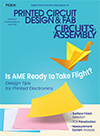News
CLINTON, NY - Indium Corp. announced today a surcharge on its Ag- and Sn-containing solder pastes, effective immediately. Since January, tin has increased to $6.25/lb. from $3.36/lb. and silver has increased to $203/lb. from $133/lb. The metal cost for Pb-Free SAC 387 solder alloy rose from approximately $8.27/lb. to $13.68/lb., a 65% increase. Metal costs have been increasing steadily the past year; elevated prices are expected to prevail for the remainder of 2007. The surcharge will be eliminated when prices return to January 2006 levels.
SAN JOSE – February worldwide sales of semiconductors fell 6.5% from January to $20.09 billion, SIA reported today. February sales increased 4.2% from $19.28 billion February 2006. “While seasonality clearly contributed to the decline, declining unit shipments and lower average selling prices in several key market segments were a factor,” said SIA president George Scalise. “Unit sales of microprocessors were up almost 8% while ASPs declined 15%, and NAND flash units grew by over 40% while experiencing a nearly 50% drop in ASPs. PCs and consumer products now account for approximately 60% of semiconductor sales,” he said. Overall capacity utilization fell to 86.8% in the fourth quarter from 88.9% in the third quarter. Most of the decline was in foundry utilization, which fell to 80.9% in the fourth quarter from 91.5%. The lower capacity utilization reflected reduced inventories within the supply chain, a move expected to bring production in line with GDP performance in key world markets.
JERSEY CITY, NJ – Cookson Electronics has announced a surcharge on Alpha brand Sn-bearing solder pastes, effective 30 days from customer notification. A global shortfall in tin supplies versus forecasted consumption has pushed prices to 19-year highs. Tin prices have increased from a range of $6,000 to $9,000/metric ton during 2006 to more than $14,000/metric ton this quarter. Cookson said it would eliminate the surcharges when prices return to mid-2006 levels.
BANNOCKBURN, IL - The revision of a standard on halogenated flame-retardant use is ready for industry comment. IPC invites all interested parties to submit comments on the final draft of IPC-WP/TR-584A, “Halogenated Flame Retardants in Printed Circuit Boards and Assemblies (Correcting the Misunderstandings on ‘Halogen-Free’).” A PDF is available; contact Tom Newton at TomNewton@ipc.org. The comment period closes April 30.
WASHINGTON – A new report issued this week by trade group AeA reiterates that America must act now to stem the loss of its competitive advantage. The report, “We Are Still Losing the Competitive Advantage: Now Is the Time To Act,” is a sequel to an AeA report of two years ago. The original asserted the U.S. was at risk of squandering its preeminence in science, technology and innovation in the face of greater emphasis on those areas by other nations coupled with domestic neglect of the factors that form the basis for its lead. The latest edition reinforces that conclusion and calls for immediate action. Recommended steps include improving K-12 math and science instruction; increasing federal funding for basic research in the physical sciences, engineering, math and computer sciences; giving green cards to all US educated masters and doctoral students, and ensuring access to broadband for every American within five years. The report includes other recommendations for timely action, a timeline of what has happened in the last two years to move the competitiveness debate forward, testimonials from executives in the high-tech industry, and updated data and analysis. To download the report, go to www.aeanet.org/competitiveness.
SANTA CLARA, CA – UP Media Group today announced a seasonal switch in schedule for PCB Design Conference East and West. Beginning in 2008, PCB West will be held in the fall in the Silicon Valley. PCB East will move to the spring, with the 2008 show being held in the Chicago area. The exact dates and location will be announced soon.


